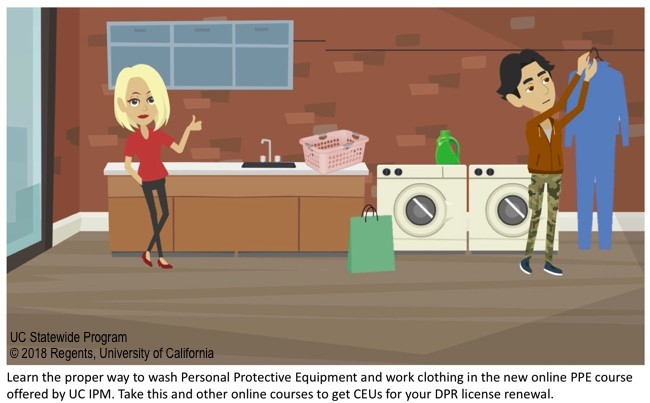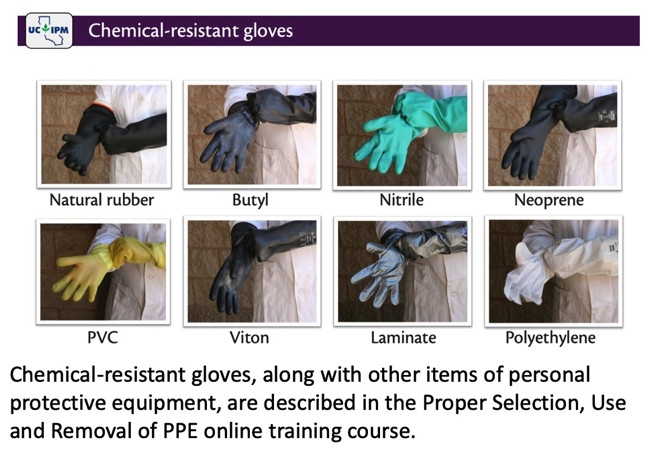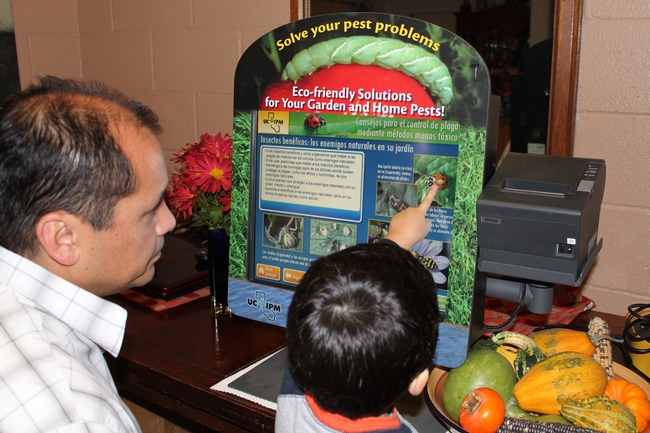- Author: Cheryl Reynolds
This spring if you are looking for options to obtain your continuing education units (CEUs) and not sure where to get them, why not check out the online options that the UC Statewide IPM Program (UC IPM) has to offer. For license and certificate holders from the California Department of Pesticide Regulation (DPR) with last names beginning with the letters A through L, 2020 will be the year to renew.
UC IPM currently offers 16 online courses for DPR credit. Many of the courses are also accredited by the California Structural Pest Control Board (SPCB), Certified Crop Advisor (CCA), Western Chapter of the International Society of Arboriculture (WCISA), or Arizona Department of Agriculture.
If you are looking for CEUs in the Laws and Regulations category, check out these courses:
- Proper Pesticide Use to Avoid Illegal Residues (2.0 Pesticide Laws & Regs)
- Proper Selection, Use, and Removal of Personal Protective Equipment (1.5 Pesticide Laws & Regs)
- Providing IPM in Schools and Child Care Settings(1.0 Other and 0.5 Pesticide Laws & Regs)
Some of our courses do require a fee and are being offered at an early-bird price through October 31st. These courses can be purchased individually, or they can be purchased as a 4-course bundle for a special price of $85—a total discount of $20 versus purchasing each course separately.
In addition to offering online courses, UC IPM also hosts a monthly webinar series sponsored by
the Citrus Research Board. The UC Ag Experts webinar series is designed for growers and pest control advisers. It includes presentations on various pest management and horticultural topics, primarily for citrus and avocados. The next webinar will be held on April 8th from 3 PM until 4 PM with Dr. Elizabeth Grafton-Cardwell, UC Riverside Department of Entomology and Extension Specialist, speaking about citricola scale. This webinar has been approved for one hour of Other CEUs from DPR and 1 hour of IPM units from CCA. Registration is currently open. View past webinars on the YouTube UC Ag Expert Talk Playlist. CEUs are only available for attending the live webinar.
DPR always encourages license and certificate holders to avoid the last-minute rush and renew early to ensure your license will be renewed by January 1st. Take advantage of UC IPM's online courses and webinar series to get a jump start on your renewal today!
- Author: Cheryl Reynolds
Learn about opportunities to receive continuing education hours. October is upon us and before you know it, we'll be wrapped up in the busy holiday season. If you hold a license or certificate from the California Department of Pesticide Regulation (DPR) and have a last name that begins with letters A through L, this is your year to renew. DPR encourages license and certificate holders to avoid the end-of-the-year rush and submit renewal applications by November 1.
Early renewal has its advantages. DPR can take up to 60 days to process a renewal application. Submitting applications now not only avoids late fees and gives you time to fix any problems that DPR may find, such as not having enough continuing education (CE) hours to renew, but also ensures that you will have your new certificate or license by the first of the year.
Without a renewed license in hand, you are not allowed to use or supervise the use of pesticides after January 1, 2019 until you receive it. You also run the risk of having to retest if there are problems with the renewal application and not enough time to fix them.
If you need a few last-minute credits, take a look at the online courses the UC Statewide IPM Program (UC IPM) offers:
Laws and Regulations
- Proper Selection, Use, and Removal of Personal Protective Equipment (1.5 hours) $30.00 charge NEW for 2018
- Proper Pesticide Use to Avoid Illegal Residues (2 hours) $40.00 charge
- Providing Integrated Pest Management Services in Schools and Child Care Settings (1 hour Laws and Regulations and 1 hour Other)
Other
- Citrus IPM: California Red Scale (1 hour)
- Citrus IPM: Citricola Scale (1 hour)
- Citrus IPM: Citrus Peelminer (1 hour)
- Citrus IPM: Citrus Red Mite (1 hour)
- Citrus IPM: Cottony Cushion Scale (1 hour)
- Citrus IPM: Forktailed Bush Katydid (1 hour)
- Pesticide Application Equipment and Calibration (1.5 hours)
- Pesticide Resistance (2 hours)
- Tuta absoluta: A Threat to California Tomatoes (1 hour)
- Urban Pesticide Runoff and Mitigation: IPM – Pesticide Properties (1 hour)
- Urban Pesticide Runoff and Mitigation: Impact of Pesticides - Urban Pesticide Runoff (1 hour)
- Urban Pesticide Runoff and Mitigation: Water Quality and Mitigation: Bifenthrin and Fipronil (1 hour)
- Urban Pesticide Runoff and Mitigation: Herbicides and Water Quality (1 hour)
UC Agriculture and Natural Resources (UC ANR) is also offering monthly webinars on specific pest issues for CEUs. More information can be found on the UC Ag Experts Talk website.
Check out the list of DPR-approved continuing education courses. For more information about license renewal, visit DPR's licensing and certification webpage.
Learn about pest management and other training opportunities from UC IPM.

- Author: Cheryl Reynolds, UC Statewide IPM Program
As summer continues to heat up, keep in mind that regulations remain in effect to reduce the volatile organic compounds (VOCs) that can be emitted into the atmosphere by pesticides and other harmful chemicals and contribute to the amount of ozone or smog in the environment.
Calculators from the Department of Pesticide Regulation (DPR) that determine the VOC emissions from fumigant and non-fumigant pesticides before application are available to help growers, pest control advisers, and pesticide applicators comply with the regulations. The UC Statewide Integrated Pest Management (IPM) Program provides a link to these calculators from each of the treatment tables in the UC Pest Management Guidelines. Click on the Air Quality – Calculate emissions button.
Take steps to reduce VOCs. Avoid emulsifiable concentrate (EC) formulations as they release the highest VOC emissions. Pesticide control advisers and growers can also reduce VOC emissions by employing IPM practices such as using resistant varieties, traps, exclusion, and biological control. When using pesticides, spot-treat and seek low-emission materials. Solid formulations, such as granules or powders, are best.
Check the fact sheet on the DPR web site for the most up-to-date-information on VOC restrictions and regulations.

- Author: Cheryl Reynolds
The UC Statewide IPM Program has many resources available to help Spanish-speaking audiences manage pests and apply pesticides safely.
For our Spanish-speaking urban audiences, several short videos on common pests such as ants, spiders, snails, bed bugs, and mosquitoes are available as well as Quick Tips (Notas Breves) offering advice on many pest problems and information on using pesticides safely. There are also 16 touch-screen computer kiosks located in various locations around the state where users can find pest and pesticide information in English or Spanish.
For maintenance gardeners preparing to take the California Department of Pesticide Regulation's Pesticide Applicators exam in the category Q, UC IPM offers a study guide and free online training course in Spanish.
For agriculture audiences, there are several pesticide safety-related books and DVDs available as well as guidelines for managing strawberry pests.
For more on other pest management and pesticide safety information available, please see the UC IPM Web site.




